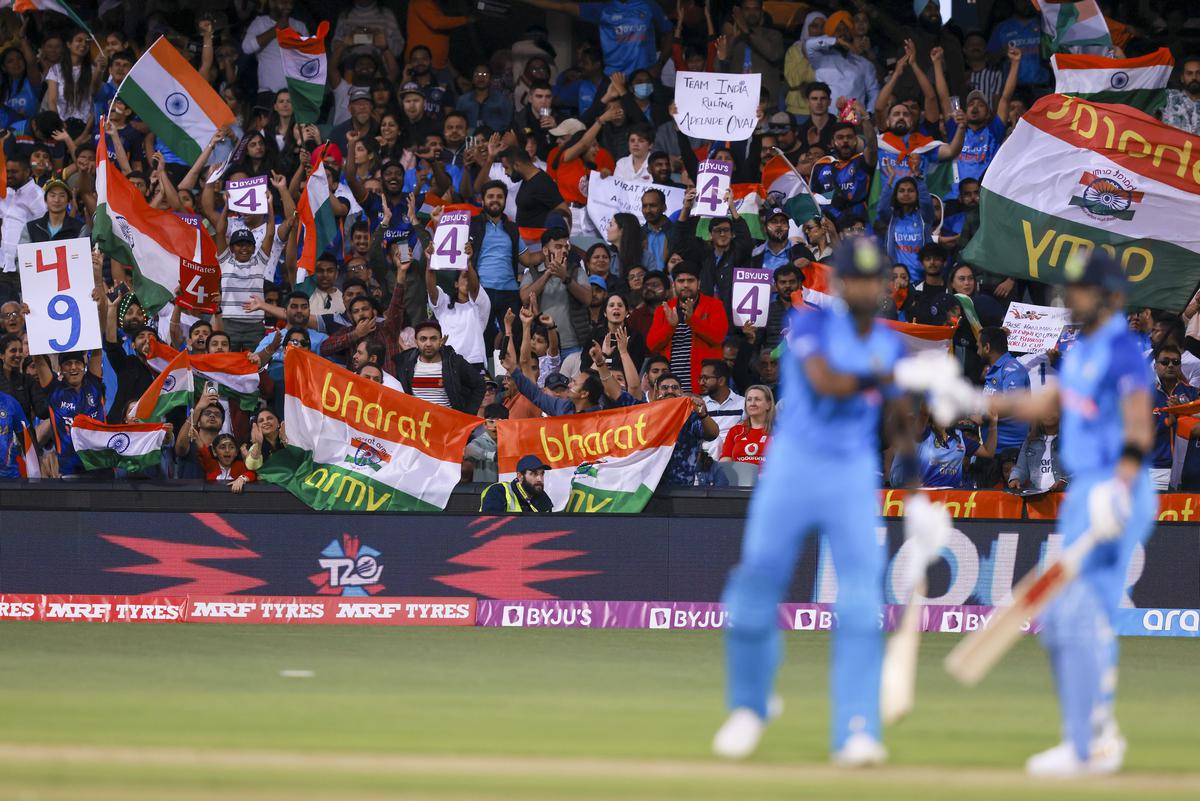Amid a sea of blue in Australia

Indian fans at the T20 World Cup cricket semifinal between England and India in Adelaide, Australia
| Photo Credit: AP
Indian cricket fandom is global in reach. During the 2019 World Cup, India and Australia were all set to clash at London’s Oval. Ahead of the encounter, Aussie skipper Aaron Finch grinned and said that this could feel like India’s home ground considering the support that the Men in Blue always garner.
The next day, sportswriters reached the Oval, which could well have been Mumbai. The atmosphere was overwhelmingly desi, with the aroma of samosas wafting across the stadium. Fans in blue outnumbered their Aussie counterparts. Finch was absolutely right.
Leaping across time and geography, from 2019 to 2022 and from the northern hemisphere to the southern half, where the ICC Twenty20 World Cup hurtled across Australia, the story was no different. Indian fans were the most vociferous, whether in Melbourne, Sydney or Adelaide. If there was a twist, it lay in the weather, as there were cold and damp streaks in a season called summer.
Years ago, when the term demographic dividend was not as much in vogue as it is now, tennis star Sania Mirza said: “We are so many of us.” This rings true when you track Indian sport, specifically cricket. That Indians, be it those at the stadium or those glued to the television, have an enormous impact on cricketing logistics and commerce is evident from the schedule that Rohit Sharma’s men enjoyed at the T20 World Cup. India had more Sunday prime-time games while even the host, Australia, did not get such preferential treatment.
The atmosphere in Australia
In Australia, when India took on Pakistan in what turned out to be the championship’s best match, the atmosphere was electric. It was a sea of blue with a pinch of green. Out in the stands, there was good-natured banter. Some fans even wore a split jersey with one half green and the other half blue, and belted out the evergreen Yeh Dosti number. During the game, a fan from across the border held up a placard: “Virat Kohli, please come to Pakistan and score a century.” Kohli won the game for India. The next day, Najeeb, a follower with roots in Lahore, told Indian journalists: “You guys killed us man, Kohli was incredible.”
However, fans who demand every inch of their idol’s life can be obnoxiously intrusive as Kohli learnt the hard way. When the Indian team was in Perth ahead of the tournament, two hotel staff filmed the former Indian captain’s room. It was a gross violation of Kohli’s privacy and it forced the star to lodge an official complaint. But by then, the video had blitzed through WhatsApp.
The Indian fan constituency wasn’t just about the diaspora in Australia; it was also bolstered by people flying in from India, the U.S., Canada and Europe. Arvind Desai and his friends from England tailed the Men in Blue. “We are following India. Between the games, we do the touristy things,” he said from an adjacent seat on a flight in Australia. Another fan reportedly flew in from Texas at the last minute and spent nearly ₹15 lakh just to get a glimpse of India’s last-stage performance.
But this love isn’t unconditional; it is often fixated on nationalism. And collective self-esteem is linked to how the national team fares. When India crashed out in the semifinal against England, anger simmered among some followers and social media turned toxic. But this is a transient sentiment. If you feature India in another global tournament, the fans will fill up stadiums with their chants, whistles, drums and cheeky placards. And if India presses the exit button, the fans will sell their tickets, just as they did prior to the latest final. Pakistani fans made the most of their luck at Melbourne, but it was Jos Buttler’s England that had the last laugh.
For all the latest Sports News Click Here

